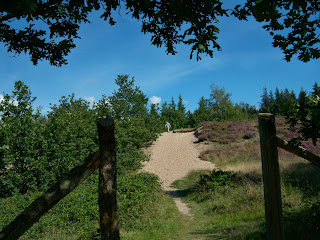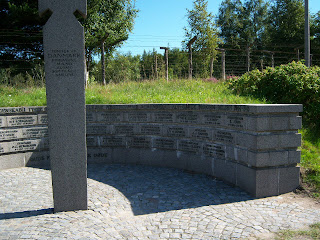Froslev.
One town in Zealand, agricultural area;
and this in Jutland, a former Nazi Internment Camp WWII
It is not a waste of time to go to the Zealand Froslev, thinking it is the WWII Froslev. People are helpful, and we found a medieval tower in the middle of a farm there.
But if your time is pressed, search for "Internment" and not just Froslev, in finding your way.
Froslev, Denmark, is currently in the news because Denmark has tightened its borders with other European Union countries, including Froslev's nearby border crossing to and from Germany. See http://www.forexyard.com/en/news/Reuters-World-News-Highlights-1800-GMT-July-5-2011-07-05T180000Z We crossed without stopping. Now, not so.
Immigration to Denmark is not as free as it was recently. As part of the European union to date, Denmark had permitted free access back and forth across its borders without checks on papers. Denmark is asserting rights to scrutinize who enters.
Froslev is otherwise known for its World War II internment camp,
 Rroslev Internment Camp, Jutland, DK. Guard tower.
Rroslev Internment Camp, Jutland, DK. Guard tower. 1. Purpose of camp,
The Froslev Camp was built to cage political prisoners, members of the Resistance that were spared somehow from summary trials and executions, by connections or whatever, see http://www.visitdenmark.com/island/is-is/menu/turist/oplevelser/attraktioner/produktside.htm?wbc_purpose=Bas?CallerUrl=1&wbc_purpose=Bas&Id=006174; or other high ranking persons opposed to Nazism (Germany occupied Denmark from 1940-1945).
Froslev was not a place to collect Jews, gypsies, other ethnic or mental "defectives" or challenges to Naziism as a whole, not a labor camp, not an extermination camp, not a concentration camp. Froslev was a severe but manageable holding pen. These were, after all, fellow "Aryans" - the master white race -- even if temporarily misguided.
2. Keep Denmark happy.
It was a nod by Germany to its need for Danish cooperation (not another military front). It required hard work for some (just the rebellious?), but provided basically decent living and diet conditions, There was always threat. My understanding is that Danes ran the camp, at Nazi bidding; and did follow orders to transport rebellious prisoners to Theresienstadt CZ or other concentration and labor and extermination camps in Germany's territory.
 Froslev Internment Camp DK, sand pit work area, Jutland, DK
Froslev Internment Camp DK, sand pit work area, Jutland, DK3. People still died here, or were transported elsewhere for death, or a chance at survival if they were lucky
There are memorials to those who died, or who were transported to Theresienstadt, CZ, for further disposition.
Some 1,600 prisoners of the German Security Police were transported to German camps; with some total 8,000 interned here. See http://www.visitdenmark.com/island/is-is/menu/turist/oplevelser/attraktioner/produktside.htm?wbc_purpose=Bas?CallerUrl=1&wbc_purpose=Bas&Id=006174
Yet, the numbers of deaths compared to other facilities is small. Today, Froslev has its museum, see http://www.ww2museums.com/article/1662/Fr%F8slevlejrens-Museum-Fr%F8slev-Prison-Camp-Museum.htm is cheerful, sterile. Kids come for summer and other programs. Use the facility.
 Froslev Internment Camp, renovated for Youth ad other use,
Froslev Internment Camp, renovated for Youth ad other use, 4. But this looks so nice?
Denmark made a choice for use for the future, over memorial to the past; but keeps the past alive, in its way.
There is tension between preserving what was, to show what inmates endured; and reusing facilities for the future. These are renovated, repainted, nicely presented new uses.
To be sent to Theresienstadt was a virtual death sentence because of the transports out to death or labor camps. See the site for the Czech Republic Theresienstadt; then see a Theresienstadt (Terezin) timeline at http://www.ushmm.org/wlc/en/article.php?ModuleId=10007460
Our understanding is that troublemakers from here at Froslev were transported to Terezin, or Theresienstadt.
 Guard tower view, Froslev Internment Camp, Froslev, Jutland, DK
Guard tower view, Froslev Internment Camp, Froslev, Jutland, DKFurther memorial, deaths at Froslev.
The museum houses caricatures of HItler and the "situation" -- fair use. Are these inmates' artistic renditions, or examples of resistance propaganda? Have to go back.
 HItler puppet caricature, Froslev Internment Camp, Froslev, Jutland DK (fair use)
HItler puppet caricature, Froslev Internment Camp, Froslev, Jutland DK (fair use)A favorite theme is puppetry. Who is pulling whose strings.
And the familiar imagery of the ostrich: head in sand. Whose, when?
An overall theme is the moral dedication of Danes, as they see themselves, through the ages as warriors for good causes. Denmark, and worldwide. See the scope of apparel, uniforms, equipment.
Always to remember: Deprivations can be huge, but they are relative. Inmates here, however, were privileged and not personally attacked as inferiors, as were the ethnic and religious targets of other parts of Europe. They did have the basics for sustenance, reasonable health. They had some heat, a basic diet, and were not abused or beaten to death. These were political prisoners with clout, and family connections, and political connections. They wrote letters, and got letters back. It paid to be an Aryan.
The Nazis here, at this internment camp as opposed to labor and extermination camps elsewhere, did not engage in widespread extermination of intellectuals, dissenters.
They killed ordinary members of the Resistance who had not these connections that could benefit the Nazis, but only sent those for further disposition elsewhere, if they did not behave.
Sp. shiver, but have some basic heat.
 Stove for barracks, Foslev WWII Internment Camp, Jutland, DK '
Stove for barracks, Foslev WWII Internment Camp, Jutland, DK ' At
 Frpslev Museum, Internment Camp during WWII, Jutland, KK.
Frpslev Museum, Internment Camp during WWII, Jutland, KK.After the war, German officials and other ranking persons, including Danish collaborators whose actions to support the Nazis came under scrutiny, were held here until further disposition. Did any from Denmark warrant trial at Nuremberg?
Denmark did win special treatment for its high-ranking and respected political and respected resistance officials and directors. Collaboration, and whether principles should be compromised in order to fight another day, never resolved. Fair use here of an extensive total exhibit.
The pretty barn-red colors were not there then.
 Memorial, Froslev Internment Camp, rebellious inmate sent for further "disposition" through Theresienstadt CZ and elsewhere.
Memorial, Froslev Internment Camp, rebellious inmate sent for further "disposition" through Theresienstadt CZ and elsewhere. Layout, Froslev WWII Internment Camp, Jutland, DK
Layout, Froslev WWII Internment Camp, Jutland, DK Renovated inmate barracks, now arts and youth uses, Froslev Internment Camp, WWII Jutland, Denmark.
Renovated inmate barracks, now arts and youth uses, Froslev Internment Camp, WWII Jutland, Denmark. Memorial Frpslev Nazi Internment Camp, Jutland, Denmark
Memorial Frpslev Nazi Internment Camp, Jutland, Denmark Puppetry caricatures, Nazi officials, Froslev Internment Camp, Jutland, DK, WWII
Puppetry caricatures, Nazi officials, Froslev Internment Camp, Jutland, DK, WWII Nazi head in sand cartoob fair use, Froslev Internment Camp, Jutland, DKi
Nazi head in sand cartoob fair use, Froslev Internment Camp, Jutland, DKi Danes as Warriors, for Denmark and Others, Exhibit portion, Froslev Internment Camp, Jutland, DK
Danes as Warriors, for Denmark and Others, Exhibit portion, Froslev Internment Camp, Jutland, DK Danes in uniform serving humanity's causes, fair use, Froslev Internment Camp exhibit, DK
Danes in uniform serving humanity's causes, fair use, Froslev Internment Camp exhibit, DK Froslev Internment Camp, WWII Jutland DK. Crowded, severe. but not life-threatening in itself.
Froslev Internment Camp, WWII Jutland DK. Crowded, severe. but not life-threatening in itself.
No comments:
Post a Comment